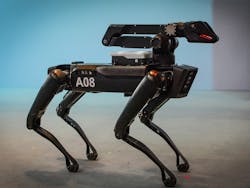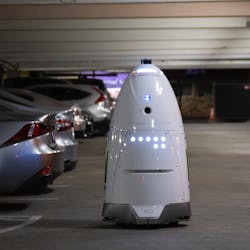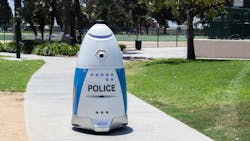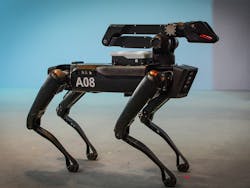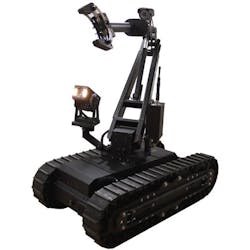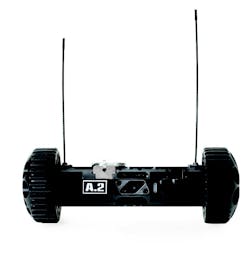It’s smooth, hairless, and black. It walks on four legs and its appearance is more than a little creepy. It’s a new breed of police canine. But this four-legged crime sniffer, named Spot, is not alive; it is robotic.
Spot is a robotic dog from Boston Dynamics, which may soon find a place among badge-carrying officers on police forces across the country.
The Massachusetts State Police tried out Spot for three months, from August to November 2019. Media reports share that the agency used Spot in two unspecified, real-life incidents—besides testing—to give officers an insight into crime scenes from a safe distance.
State Police Spokesperson David Procopio wrote in a statement after the pilot: “Robot technology is a valuable tool for law enforcement because of its ability to provide situational awareness of potentially dangerous environments.”
Skeptics, however, call Spot “terrifying” and its use has raised cries from civil rights advocates and law enforcers alike. Civil rights activists question law enforcement oversight of robot use, law enforcement managers complain about its impact on their budgets, and law enforcement officers worry about robots taking their jobs.
He adds robots help rather than hinder cash-strapped, officer-short agencies. “The current business model of law enforcement is not scalable,” he says. “Everyone is getting their budgets cut. If we do things the same way we always have, we will wind up in a very difficult situation.”
Stephens sees robots as the future of policing. He says these electronic officers will improve police efficiencies, serve as force multipliers, and provide operational intelligence that keeps officers out of harm’s way.
Robots in place
In January 2019, Juan Roman splashed gasoline on the floor of a Novato, Calif., gas station, then threatened to light the gasoline on fire. Roman fled the scene and holed up at another gas station, leading to a six-hour standoff with police. Finally, the suspect agreed to surrender if police provided him with cigarettes. A robot delivered the goods, and the standoff ended peacefully.
Cases like Novato, Calif., where a robot enters harm’s way instead of an officer may become the norm as police robots become more commonplace. Companies like Boston Dynamics, Knightscope and SuperDroid are working on robots that make traffic stops, hand out speeding tickets, patrol streets, surveil areas, detonate bombs, clear debris at accident scenes, and make intense situations less dangerous.
To understand how, one needs basic understanding of how police robots operate. It’s a misnomer to think police robots are autonomous; these rolling tech-forward officers currently cannot do anything without human interaction. Police robots do not think for themselves or make decisions. Human officers control their moves remotely.
Most robots operate wirelessly, and operators control them via remote, much like a remote-control car. Others come with software that allows officers to operate them from their smartphones or their laptops.
Manufacturers put rubber tires or treads on robots, which enables them to navigate rough terrain with ease. Boston Dynamics’ Spot, however, operates on four legs.
Companies further augment robotics technology: video cameras able to record what the robot sees and transmit video feeds back to officers; night vision and infrared capabilities give the robot eyes in the dark; and tools that operate like hands to enable robots to open doors, look in packages or disable a bomb.
Some units come equipped with facial recognition software utilizing machine learning to detect, analyze and compare faces. When these robots are put at an entrance to an office building, for example, they quickly learn to identify the faces that belong and faces that appear out of place.
Available bots
The number of available robots for professional use continues to grow—a trend that’s expected to continue well into 2023. MarketsandMarkets forecasts the smart robots market will grow from $4.9 billion in 2018 to $14.3 billion by 2023. The research association predicts the major factors driving market growth include the rapid adoption of autonomous robots for professional services, emerging technological advancements in the field of robotics, increasing investments toward industrial automation, and growing government aid for R&D of artificial intelligence-enabled robots.
Some of the robot offerings available for police use today include:
Knightscope
This Mountain View, Calif., company offers stationary and roving sentinel robots to watch entrances and exits. The Knightscope Security Operations Center allows officers to connect to Autonomous Security Robots from their smartphones, tablets or PCs.
“The best way to combat crime is through actionable intelligence, and the best way to gain actionable intelligence is through some form of intelligent eyes and ears,” says Stephens.
After the Sandy Hook shooting and the Boston bombing, Stephens pondered how to better advance law enforcement’s mission in mass emergencies. He and his business partner decided robotics was the answer, and set to work creating a robot that met two goals: to offer a level of conspicuousness and to be able to gather intelligence.
“When they teach you the use-of-force continuum in the Academy, the first rung on the ladder is having a commanding presence. We built a robot with a commanding presence,” he says.
The robot also had to provide real-time data that officers could use to make smarter and safer decisions.
Knightscope then introduced the robot to corporate clients like casinos, airports, and shopping malls before knocking on law enforcement’s door. “We wanted to look at law enforcers and say, ‘Anywhere we deploy a robot, we see a 50% reduction in crime,’” he says. “We actually have clients who report a 100% reduction in crime. Agencies look at those numbers and say, ‘Wait a minute. If the private sector gets those results, what might we see?’”
Each one of Knightscope’s robots is intended for a different role. The K1 works indoors and outdoors but is stationary. It works well at ingress and egress locations, and places with smaller footprints. The K3 works well in indoor environments, such as large warehouses and commercial shopping centers, and comes with facial recognition technology. The K5 works well outdoors for perimeter protection. It is useful in large parking structures and corporate campuses—anywhere that has smooth level surfaces. The K5 offers license plate recognition and thermal imaging capabilities.
All robots offer 360-degree fields of view and record high-definition video and have two-way intercom systems and pre-recorded messaging capabilities.
“If an agency seeks to increase their presence, they should place this robot in as conspicuous place as possible so that the public knows there is a police presence there,” Stephens says.
Boston Dynamics
The company makes the robot of metal and it walks on four legs. It has a long arm, known as the Spot ARM which enables the robot to open doors, reach into areas and grab objects. The robot uses stereo cameras to avoid obstacles and people as it moves throughout a scene. Its Spot CAM captures spherical images and comes with an optional PTZ camera with 30X optical zoom to conduct detailed inspections. The general-purpose robot is open architecture, which means it integrates with other software through an application programming interface (API).
Users control Spot with Autowalk, which lets them record and replay autonomous actions. Officers use Autowalk to drive Spot around and surveil and record a scene. It also lets them execute movements and actions.
Michael Perry, Boston Dynamics’ vice president of business development, shared with the media that Boston Dynamics sees Spot being used in oil and gas companies, at construction jobs sites, and in law enforcement. He said he envisions police sending Spot into areas that are too hazardous for a human, such as a chemical spill, a suspected bomb event or a hostage situation.
The robot is available through a leasing arrangement. The leasing agreement includes a clause that bans end-users from using the robot to harm or intimidate people.
SuperDroid
“The robots provide a safe distance between the operator and the team going in and the potential danger of the situation,” says Channce Rising, a robot technician for SuperDroid. “The robots go in remotely. They can sweep rooms, and if agencies get a robot with an arm on it, the robot can open doors and manipulate objects. They can even add tools so they can check out a bag, investigate a cabinet or break a window.”
Rising says the local police department in Raleigh operates a small SuperDroid throw ball robot and a larger robot with a six-axis arm. “They use the larger robot to get into a room and move things out of the way, then they send in the smaller robot,” he says. “The smaller robot can fit into tighter spaces to see under or behind or inside things.”
SuperDroid robots work up to a half mile out if the controller has a line of sight for the robot, according to Rising. When operating in a wood line or in an urban environment, he says the signal weakens.
The weatherproof and drop-resistant robots are intuitive and operate with a joystick. The cameras on the robots operate the same way. Basic maintenance and regular battery charging keep the robots ready to go when needed.
“Our robots increase the distance between officers and possible harm,” he says. “They also offer surveillance. If you need your eyes on a certain location but cannot be there physically because of a lack of manpower or whatever, you can have it surveilling the scene and check the scene from where you are.”
Endeavor Robotics
The throwable and expandable FirstLook from Endeavor Robotics is a compact, rugged and lightweight robot that provides situational awareness. It’s used to explore and surveil dangerous areas.
Endeavor Robotics SUGV is a backpack-portable robot with dexterous manipulation for dismounted and mobile operations. It is larger than FirstLook and provides dismounted EOD technicians and other responders with a mobile, 30-pound robot that climbs stairs, manipulates objects and speeds down-range at over six mph. Officers can carry the portable SUGV and deploy it from a pack.
The company also offers the Packbot for bomb disposal, surveillance and hazardous materials handling, and the Kobra, which can carry up to 330 pounds and extends up to 11 feet.
ReconRobotics
Once deployed, officers can direct the robot to move through a structure transmitting real-time video and audio back to them, allowing them to locate and identify subjects while revealing the room layout.
ReconRobotics can reconfigure the Throwbot 2 robot with optional configuration packs to handle more terrain like the Recon Scout XL robot or transport payloads like the Recon Scout CT robot.
If officers use the Throwbot 2 with a Recon Scout SearchStick, it functions as a pole camera allowing them to inspect attics, rooftops and crawl spaces.
“When the company came on the scene in 2007, all military and police robots were large and complex and operated only by trained experts,” said Mack Traynor, CEO of ReconRobotics. In regards to the Throwbot 2, he added that “the vision was radically different: give warfighters, SWAT operators, and law enforcement an incredibly simple, personal system that weighed one pound and allowed them to remotely deploy video, infrared and audio sensors to reveal hidden threats. What we are most proud of is the countless lives these 5,500+ deployed systems have saved over the last 10 years.”
Have a plan
Before deploying any robot, Stephens says agencies need to have a plan. They need to know when, where, and how they will use the robot; where they will send alerts or video footage; and how they will store data.
“There needs to be a standard operating procedure (SOP) in place before deploying them,” Stephens says.
Questions to think about:
- Who will operate the equipment?
- Where will it be stored?
- What is the chain of evidence for captured video footage?
- Who will view captured video once the robot is deployed?
- What will you tell the public and officers about the new technology?
“The communication piece is extremely important,” Stephens says. “We should view robots as another security tool. We need to make sure officers and the public know that robots are not artificial intelligence that takes over the world, eliminates jobs and abuses the public.”
With an SOP in hand, agencies can step into the future of law enforcement. “Robots help law enforcement become more forward-thinking. It shows they are taking steps to protect officer safety and that they take officer safety seriously.”
Ronnie Wendt is a freelance writer based in Waukesha, Wis. She has written about law enforcement and security since 1995.
About the Author

Ronnie Wendt
Owner/Writer, In Good Company Communications
Ronnie Wendt is a freelance writer based in Waukesha, Wis. She has written about law enforcement and security since 1995.
